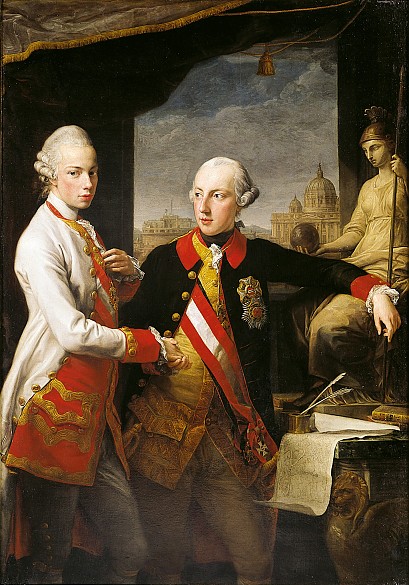The journeys of the Count of Falkenstein
Whenever Joseph II travelled, exchanging the throne for the carriage, he used the alias of the Count of Falkenstein, in order to avoid the elaborate ceremony with which he would otherwise have been treated. His assumed name was also widely associated across Europe with the defence of reason and rationalism.
The title of Count von Falkenstein was part of the Franz Stephan’s Lotharingian legacy. A small county located in the present-day Federal State of Rhineland-Palatinate, it was the only territory of the former emperor’s ancestral domains to remain under his rule following the cession of Lorraine to France in 1737. Joseph II chose this unimposing title when he wished to spare himself a time-consuming and costly official journey as emperor. Although everyone knew the real identity of the august personage concealed behind this pseudonym, it allowed Joseph more freedom of movement.
Joseph did an astonishing amount of travelling, spending more than a third of his reign on the road. This was not least motivated by his desire to get away from his mother. A ruler travelling around in his dominions to see them at first hand was a novel phenomenon. These were not court journeys or trips taken for his own personal pleasure but inspection tours which were followed by immediate measures to redress the shortcomings he had discovered.
His first journey in 1766 took him to Hungary and the borders of the Ottoman Empire. Never before had a Habsburg come to take a personal look at these remote corners of the Empire.
In 1769 Joseph travelled to Italy, arriving in Rome just as the papal enclave was meeting to elect a new head of the Catholic Church. Here too he did something entirely unprecedented: although it was forbidden to laymen, he entered the conclave together with his brother Leopold and made it perfectly clear which candidate had his backing. This was Cardinal Ganganelli, an opponent of the Jesuits, who was then duly elected pope as Clement XIV.
In the same year he also travelled across Silesia, the province that Maria Theresa had been forced to cede to Prussia, a loss that she had never truly come to terms with. Here he met Frederick the Great, his mother’s arch-enemy. To his mother’s horror, Joseph had admired the brilliant military commander since his youth, seeing in him the very model of a military ruler. He followed the Prussian king’s example by always appearing in uniform, with the result that this form of dress became accepted at court, thus strengthening the military element in court society.
After further visits to various parts of the Empire (Hungary, Moravia and Bohemia in 1770; Transylvania and Galicia in 1773) in 1777 he embarked on a journey to France which culminated in a sojourn in Paris and caused a sensation across Europe.
This journey was akin to an image enhancement campaign: in keeping with the spirit of the age, Joseph acted as a modern, enlightened monarch, staying at simple inns and travelling with a small retinue. He thus presented himself as a positive counterpart to Louis XVI and the Versailles court with its extravagance and decadence. The Habsburg monarch was adept at flattering the French, lavishing praise upon the intellectual life of Paris. He also made his mark as an innovative ruler by visiting manufactories, hospitals and cultural institutions rather than attending courtly festivities.
On the way back to Vienna he stopped off in Switzerland, where it was generally expected that he would meet Voltaire, an encounter that would have represented the apogee of Joseph’s cultivation of his own image as the ‘Emperor of Reason’. Voltaire, who was living in exile near Geneva, was the leading representative of the Enlightenment and notorious for his mordant criticism of Church and society. Despite these high expectations, the meeting did not take place. At the last minute the emperor gave the order to resume the journey, giving as his reason that he preferred writers who were also Christians.
Another journey that had consequences for European history took the emperor to Russia in 1787, where he met the tsarina Catherine II in the Crimea. Here mutual agreement was reached between the two empires that they would act in concert to oppose the Ottoman Empire, an alliance that would subsequently lead to the final war against the Turks.













